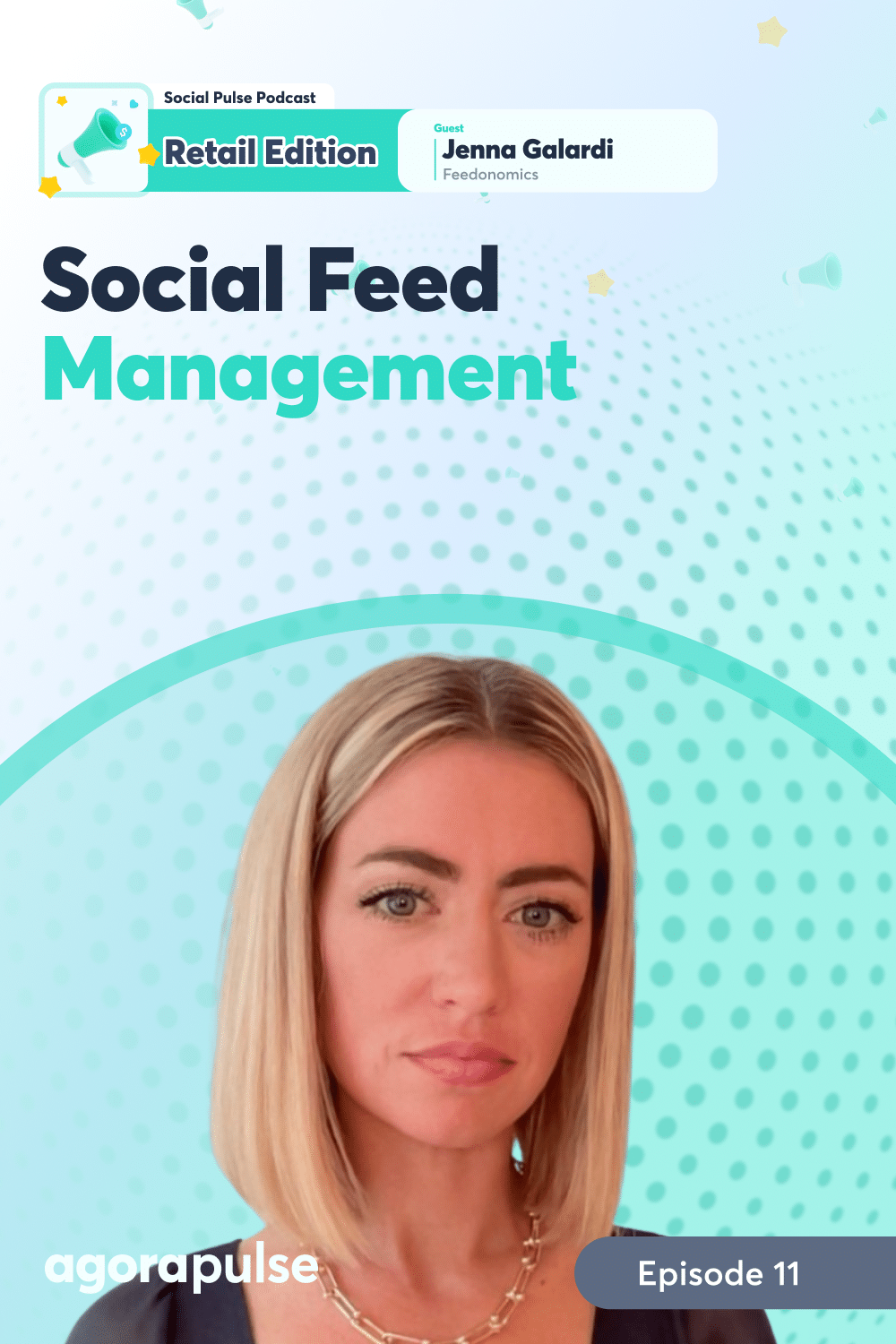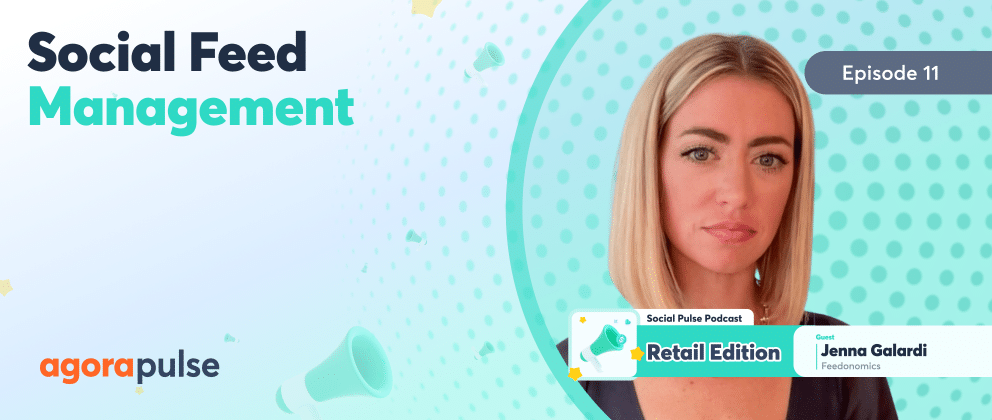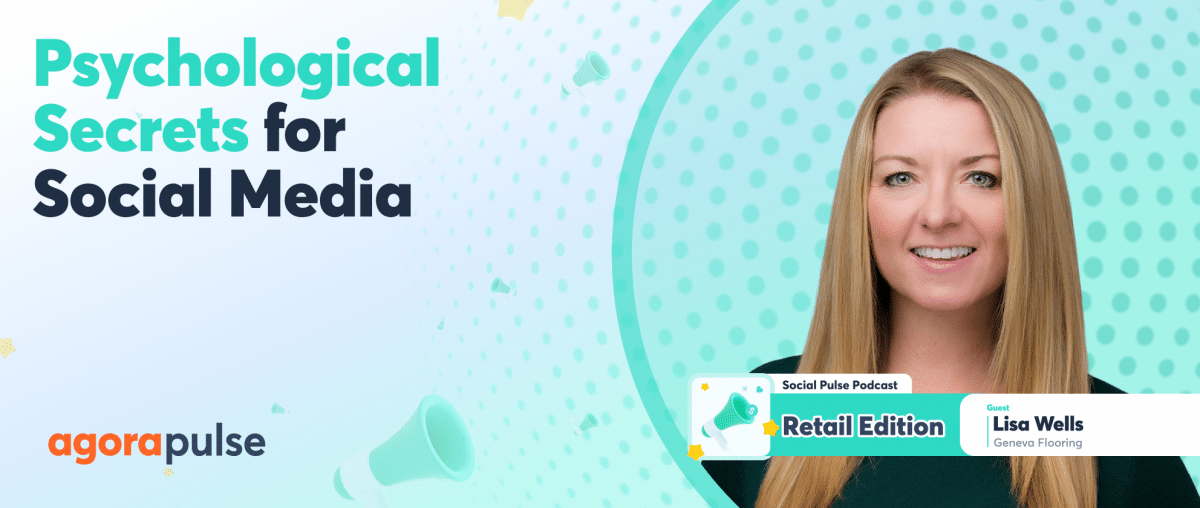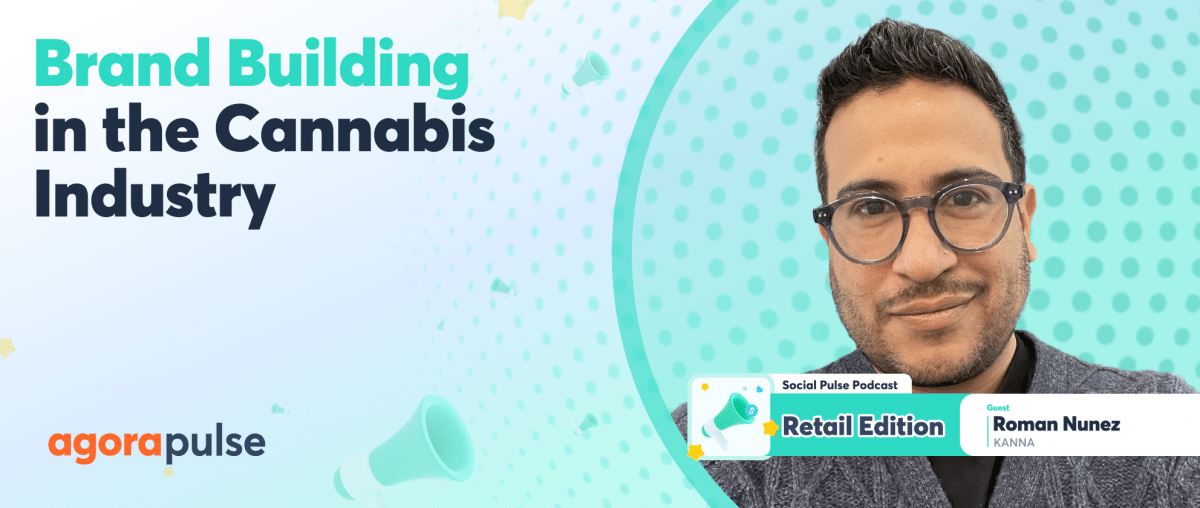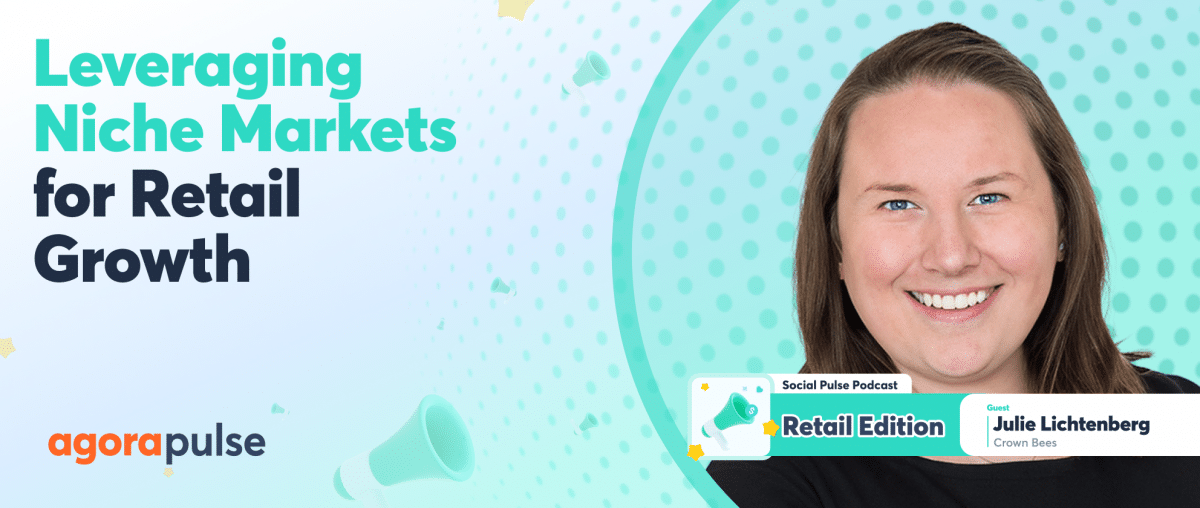Are you a retailer looking to do product feed management on social? Or are you still working out the details and basics?
The following transcript is highlights taken from the latest episode of the Social Pulse Podcast: Retail Edition with host Mike Allton. Listen to the full episode below or read on for the recap.
Mike Allton: Welcome to our chat with Jenna Galardi from Feedonomics. We’re going to be digging deeply into social commerce, selling where your audience is.
Jenna, it’s great to have you here. Please introduce yourself. And for those who aren’t familiar, please tell us a little bit more about yourself, about what Feedonomics is, what it does, and how product feed management relates to social media for retailers.
What’s Feedonomics?
Jenna Galardi: First of all, thank you for having me. My name is Jenna Galardi. I’m the director of omnichannel growth here at Feedonomics. So I come from 13 years [on the] agency side where I helped some of the largest brands like Chanel to digitally native brands like the Feelist start to grow their online presence both from an ads and marketplace perspective.
At Feedonomics, I run our consultative practice and our omni-certified tech agency program.
So we are:
- Making sure that merchants understand if they are at industry averages, how they’re performing on these channels, making sure they’re squeezing the most out of them.
- But then also looking to the future to see what the next best channels are. (A lot of times, we get unpublished information from channels.)
- Understanding what are the best ad formats, tips, and tricks—also, some different subsidies and rebates and ad credits to be able to make it easier for merchants to adopt net new channels.
What is product feed optimization?
With Feedonomics, it’s all about product feed optimization.
When you are a brand, you want your product to show up everywhere, right? Whether someone’s searching on Google, and they’re clicking that ad and coming back to your e-commerce site to check out—or if that transaction is happening on a third party, like an Amazon, a TikTok shop, Instagram checkout, Walmart, Macy’s, etc.—it’s about making sure that that product information is optimized for that channel.
If you’re sending the same blanket product information to every channel, you are not optimized for success. And I guarantee you could be performing better. So it’s really about making sure from the right media. You need a white background on Google Shopping, but you might want a lifestyle image on TikTok. So make sure that you have the right imagery, the right media, [and] the right character length.
Sometimes, where I see the biggest room for improvement—especially those first 30 days on Feedonomics–is their products are in the wrong category. We had a great example in Google Shopping recently, where a merchant, their hero product, was a short-sleeved T-shirt. And they were just sending their information before they came to Feedonomics straight to Google. Google’s AI was the one categorizing them, and they put them in the shorts/pants category because it had the word “short” in the title and “short” in the description, and they weren’t drilling down to the right category taxonomy.
There are a lot of little things that happen within product feeds and typically either agencies or internal brands. Units typically spend about 20 to 50 hours per month optimizing these feeds and dealing with errors and issues.
So it’s great to be able to have something like Feedonomics that can be fully managed, while Google Service takes on all of that feed management. You guys can spend time doing what you do best and running your business.
Mike Allton: Okay, wow. So 30 seconds in, I’ve already learned something new. I didn’t realize that each platform is displaying those products differently, and you have to adjust them accordingly. Obviously, as a consumer, I wouldn’t have noticed that.
I did want to point out that Feedonomics supports Facebook, Instagram, TikTok, Pinterest, and Snapchat. So to make sure I’m understanding and communicating correctly, we would use Feedonomics to make sure that we’re pushing products and making them available to purchase through those platforms and syncing all that data back and forth. Is that right?
Jenna Galardi: So we have two main products.
One’s advertising, so that’s optimizing for something like Google Shopping or even Instagram, right? But maybe not Instagram checkout. You’re just advertising the products. The end user comes back to your site. Now there are a lot of changes that are happening.
For example, Instagram is now saying April 24th, they’re shutting that down. You need to be able to have checkout within [your] app. So now it’s a matter of moving to a marketplace, which is our second offering: ensuring that you’re not just optimizing for the product to be sent there, but you’re also pulling that order back in to fulfill (whether that’s to your e-commerce store, your ERP, your OMS, whatever you guys want to call it) those orders and then pushing that tracking information back out.
Those are the two main setups for social that could be used for either advertising or the marketplace.
What Retail Brands Should Know About Product Feed Management
Mike Allton: That leads me to my next question. If you’re using the product to sync the advertising on Instagram, and they’re killing that off, well, then you’re going to need to make sure that you’re syncing your products and you’re shopping.
But what about everyone else? ‘
When does a retail brand need product feed management, and what are some other benefits we haven’t touched on yet?
Jenna Galardi: Typically, when we’re looking at brands, it depends on where they are in their growth stages and when they’re the right fit for Feedonomics. If they’re doing three million or more online, they’re an ideal fit. You’re going to see that lift-off within 90 days. It’s going to pay for itself. [For] some smaller brands, it might not financially make sense yet. Now they might be doing that offline or through resellers, maybe just not online, and then it could make sense. But for that white glove service that Feedonomics offers, the floor is typically around 3 million online and it’s anybody who’s selling anywhere.
“If they’re not finding you, they’re finding your competition. So it’s about that omnichannel strategy and making sure that it’s not an option anymore. It’s an imperative. Everyone needs to be listed on all different channels because if they’re not finding you, they’re going to find someone else.”
And it’s a matter of being that front-of-mind on all those different channels.
Challenges for Retail Going Omnichannel
Mike Allton: We need to make sure that our products and our brands are represented everywhere. We’ve had that approach for many years when it comes to social media. We’ve simply said, “Look, you don’t necessarily need to be active on every social channel, but you need to at least be present.” You have a channel, and I love that with your tool, it automates a lot of that presence. So I’m not trying to create products and catalogs on every single channel individually.
Jenna Galardi: Social, there’s quite a few. I think the biggest one is just how ever-changing it is and how evergreen it is, right?
They’re making consistent changes at a rapid speed. Someone’s running their business, developing the best products that they can. It’s hard to understand how many different changes are happening to those platforms. And that’s why it’s great to be able to lean on an amazing agency, why it’s great to be able to have someone that’s always going to be managing your feeds and your orders and syncing that.
So you don’t have to focus on what’s coming, what’s changing.
One of the things I love about Feedonomics is we’re always included in all of the alphas, the betas—whether it was TikTok shop when it went live in the UK and the US, we’re in all these alpha beta programs. We can see where it’s going to evolve and where it’s going to adapt.
Even changes like when it was on Google and they said, “Hey, gender is now required for apparel and footwear.” We knew that ahead of time. So we were able to be proactive vs reactive, and that’s a huge saving because that happened during the holiday season as an example, and TikTok changed a lot of their ad formats and the way that they accept products.
During the whole TikTok shop evolution and launch, we were always ahead of the game. So our merchants never had a feed that was down, or in the middle of the holiday season, they can’t sell their products.
I think that’s a big thing to ensure that you just have it up and running.
You’re not missing out on Black Friday [or] Cyber Monday, because your feed got shut down because there was a change in the platform you didn’t know about. That’s one of the biggest scary factors in ensuring that have your product feed set up.
But there are also a lot of changes. I mean, everyone’s trying to push for in-app checkout. Not only do we see huge lists for merchants when they do that. But you’re getting a lot of that data that you lost during that iOS update several years ago, and you would click off with the app, and now you no longer know, “Does that lead to a conversion or did they just go to my site?”
Now you’re gaining a lot of that data back when you’re actually within the app. And it depends on the platform, right? So Pinterest, it’s more “find now, buy later.” They’re pinning it for a later time whereas TikTok is a lot of instantaneous. I know, for me as a consumer, it was the first time I’d ever seen a new brand or new product, and I purchased it on the first view because instead of this polished look, you see a lot of times on Instagram, on TikTok, you’re seeing the product in motion. Someone’s explaining it. It’s that shopper attainment as I call it on TikTok.
And that leads to a lot higher conversions because it answers all their questions right within that video.
Mike Allton: I’ve been writing about social media for over a decade, so I can personally attest to just how much things have changed. I’ve written about each time one of these platforms has added e-commerce capability because they didn’t start that way. So it’s all new. And to your point, folks in the retail industry and every industry need to understand that it’s an evolution, right? TikTok shop is not very old in the grand scheme of things.
And so it’s continuously evolving. Same thing with Instagram and so on. So with Feedonomics, now we’ve got. These great shopping experiences and presences on all these different channels, all at the same time.
How do you think that our social media activity on the part of brands can or should change now that we’ve got this capability of audiences to purchase directly from those individual platforms?
Jenna Galardi: It does change the nature of the content.
Their algorithm is leaning more towards products vs just ads. So it’s great when you do have that capacity to shop. I think a lot of people in large brands that I speak to say, “Oh, it’s on the roadmap. It’s coming.” And the beauty of TikTok is it doesn’t need to be perfect. You can get it up and running right now.
Same thing with Instagram. If you get one feed up, it’s relatively easy to get the next one. It’s similar content. One of the things I love about TikTok Shop is you can tag in the video of someone watching it.
So, let’s say you have a large influencer or you’re sending out to local micro-influencers. They can talk about the product, and they show the products in use. You can have the capacity to tag those videos to go right to the shop to check out.
I think that’s a real game changer now you’re seeing the products. You can click it. You can check it out. Your information’s loaded from your credit card, from your shipping information. I was recently on stage and was showing something about one of our merchants, and I almost bought the solo stove right there on stage because it’s so easy to check out.
That’s one of the beauties of it is that instantaneous checkout. Keep in mind, too, that every social channel isn’t a great fit for every different target audience, every different market, and a very different product. And there’s going to be different strategies for different types of products and who you’re trying to reach. But we’ve seen huge growth in social commerce lately. And it’s starting to rival some search engines and larger, larger marketplaces that used to take the lion’s share.
Finding That Sweet Spot With UGC
Mike Allton: And I would imagine that working with influencers or customers with UGC would all be fairly organic at that point.
If you’ve got your products pushing out to these shops, they’d be able to tag them as easily as the brands can, right?
Jenna Galardi: You have a couple of different options. You can open it for anyone to tag, which is what I would recommend because then you can get just a daily user, user-generated content that they can tag.
You want to monitor it and make sure no one’s tagging something that isn’t correct. Or you can toggle and just have the people that you give the ability to tag your products. So maybe only the influencers that you’re working with. TikTok makes it easy because they have a built-in program now to be able to work with influencers.
There are also really great solutions on Impact.com where you can search for different influencers. They can manage your contracts there. You can improve the content right in there. You can plug into their analytics so you’re not relying on screenshots and if they got those analytics, it’s pulling in straight from the platform. They’re not having to give you access, but they give the platform access and you get all that data.
So you’re able to see what kind of influencers are creating the best results for you, be able to give them rev share if that’s something that you guys are interested in.
It’s changing the game because when you have someone else talking about you, it’s always a little bit better than you talking about how great you are yourself.
User-generated content is changing the game. If you’re a brand that’s just starting to dabble and maybe you’re not ready for some of those large contracts with big influencers, you can go to a site to get for 100 bucks user-generated content. It’s everyday people that you’re sending your products to. They can send you user-generated content that then you can post on your own channel and handle.
I think that’s a really great way to dip your toe in the water and get started.
Mike Allton: And, to your point, that kind of amateurish style of homemade video content seems to perform the best.
Jenna Galardi: And that’s the shop retainment that TikTok wrote so much about is you’re including that shopping aspect, but it really is entertainment. You’re seeing the product in motion and use.
We saw that transition on customers wanting more of that content and brands responding with first starting out seeing the full 360 of their products online and seeing different angles and product and use and white background.
And now I think we come to the more human, evolved state where we can see somebody using it in motion.
But, to your point, I’ve been in this industry for longer than I care to mention. I created some of the first Facebook business pages ever back in the day, and I was recently at an event for one of our clients. One of my friends went that influencer route a million years ago and is now one of the largest ones in the world. She was talking about the same thing. She created a video in her bathroom because she was thinking of a funny idea while getting ready and hit 5 million views before she even got to the event versus the ones that she planned out, which had a videographer. Sometimes it is those ones that are more organic, have great content, and just really resonate with people and have that funny tongue-in-cheek or the ones that tend to perform the best.
What are some of the differences or best practices when it comes to these product listings?
You mentioned that they’re different on all the different channels, Pinterest vs TikTok, and so on.
What should we be aware of?
Jenna Galardi: I think there are different ad formats. There is different content that performs best. The biggest thing is to look at your data. You can have different hypotheses. Some things can work for other people that might not work for you.
Try it all out. There’s no reason not to. Social media isn’t necessarily living forever.
People are constantly scrolling. On Instagram, you might have more of that doom scroll. If someone’s watching TV or doing something while they’re viewing, where TikTok is audio-first, so you want to make sure that you’re utilizing the right vertical vs horizontal. You are using audio in your video and making it easy for them to click out. If I’m thinking about it watching a TikTok video and I’m with audio-first, I don’t want to then click out to a website where I don’t have my information loaded. Bring you right into that experience. They can watch a video, click it, and purchase, and they never even have to stop that wormhole of information that they’re going into with their current algorithm.
I think that’s the biggest thing is looking out for the data. Don’t be scared to try. There’s nothing wrong with not hitting it out of the ballpark or not going viral straight out of the gate. I think, if you’re not already on these things, platforms are behind.
And this is a prime time because a lot of the big brands that have huge ad budgets, it’s turning the Titanic. It’s taking them longer just to adopt these new channels. So if you get on now, you’re going to get more bang for your buck than you will in the future. So the sooner the better. Don’t be scared and try.
Mike Allton: I would add that, we can test a lot of those ideas with just pure organic posts.
One of the easy ones that has come up year after year is whether or not you should be showing people’s faces in your images, in your videos, [or] on some platforms. It is better if you don’t, and Pinterest was notorious for not having the people’s faces. It was just detracting for whatever reason. Whereas on other platforms, you want that face, the tone, the expression to be able to know and trust. You could test that in your organic post for sure before you go through the trouble of creating the content for a product.
Jenna Galardi: And when you’re working with content creators, don’t give them such tight restrictions.
If they have certain products you want them to go after, give them the product, and let them go. They know their audience better than anyone else. A lot of times people say, “I want them to say this term. I want it to be this length. I want it to be in this capacity.”
Let them have fun! When you try a bunch of different things, that’s sometimes where you find the winners. I think just be a little more lenient and let people have that creative freedom. Listen to the people on your team. If there’s a funny trend that you can hop on to or funny music that everyone’s got in their feed right now, just follow it.
Just test it out. Try it. I think a lot of times people are too scared and too rigid to get going and that never leads to things that go viral.
Any suggestions on how brands can support products that are at mass retail, i.e. supporting the sale of something we have at Target or Walmart?
Jenna Galardi: You’re saying if your brand is in mass retail, and you want to support purchasing on mass retail, a lot of times, you can link out, and you can have those products.
Also, a lot of times people are finding products on social, right? “TikTok made me buy it,” right? That was the most trending hashtag of the past couple of years. A lot of times they’re finding it there, but then they’re going to their go-to to check out. A lot of times they’re researching on Google. If they don’t know what brand they want, they know what kind of product they want, or they’ve never heard of it. And they see it on TikTok for the first time, but then they’re going to Amazon and check out because they know they’re getting that two-day shipping. They know their information’s loaded.
So it’s just a matter of awareness and thinking about that full customer journey. But any time you can reduce that cost and not have to pay those marketplace fees is helpful. You’re going to get a little more profit there—but that’s also why social commerce doesn’t have those same marketplace fees of the Amazons and Walmarts of the world that we’re used to.
Look at social commerce as the next marketplace because that’s really where it’s going to be.
Mike Allton: It also sounds like if Target were to use a product like Feedonomics, and they would be pushing all of their inventory to a platform like Instagram, then you’d be able to tag those products on those platforms and have a purpose fulfilled.
Jenna Galardi: Target Plus is an invite-only marketplace. Feedonomics can nominate brands to be on Target Plus. We have a direct API connection to be able to upload your product feed. And, again, make sure that your product assortment that gets approved has the right title, the right description, the right information on it.
That’s key to success anywhere: Making sure that it’s set up for that platform. Instead of just blanket information across the board, you’re going to have different search queries on different platforms, and different text formats available, whether they want paragraphs, bullet points, or the right media.
Making sure you’re customizing for that specific channel is going to lead to much higher success.
The Future of Social Commerce
Mike Allton: How do you see social commerce evolving over the next twelve to eight months? Bring out your crystal ball and tell us.
Where’s all this heading? What do we need to know about?
Jenna Galardi: I think it’s getting bigger. A lot of people are concerned about this potential ban and what’s going to happen and where it’s going to go—but whether it’s TikTok, Instagram, a new platform you haven’t heard of yet that’s being built in the background right now, social commerce is here to stay.
I’ll never forget when people told me Facebook was a fad many moons ago in agency life. And I was like, “This is not a fad. This is here to stay.”
“People in general are social creatures. We want to be able to trust our family, our friends, people that we look up to in the community for referrals on products.
So, if you are not utilizing user-generated content, if you’re not working with a social media format to be able to create dialogue around your product, you’re behind the gate, so make sure you’re not behind that eight ball anymore, and you’re getting into it, embracing it. Just test it. Try it. You’re not going to necessarily hit out of the ballpark the first time, but don’t be scared to try something new.”
If you need help, we also offer complimentary consultation. So I can drop a link in here, too, if anyone’s interested. You can book thirty minutes on my calendar. I’m more than happy to go through your individual products and how we can potentially help you guys grow.
Thank you for reading the highlights from this episode of the Social Pulse Podcast: Retail Edition. Join award-winning marketer Mike Allton as he peels back the curtain with retail social media and community managers just like you, unveils the issues they’ve been struggling with the most, and explores how they’ve overcome those challenges. Ready to get your engagement up? Then it’s time to sign up. Subscribe today.
Brought to you by Agorapulse: the #1 rated social media management solution trusted by over 3,000 agencies.
